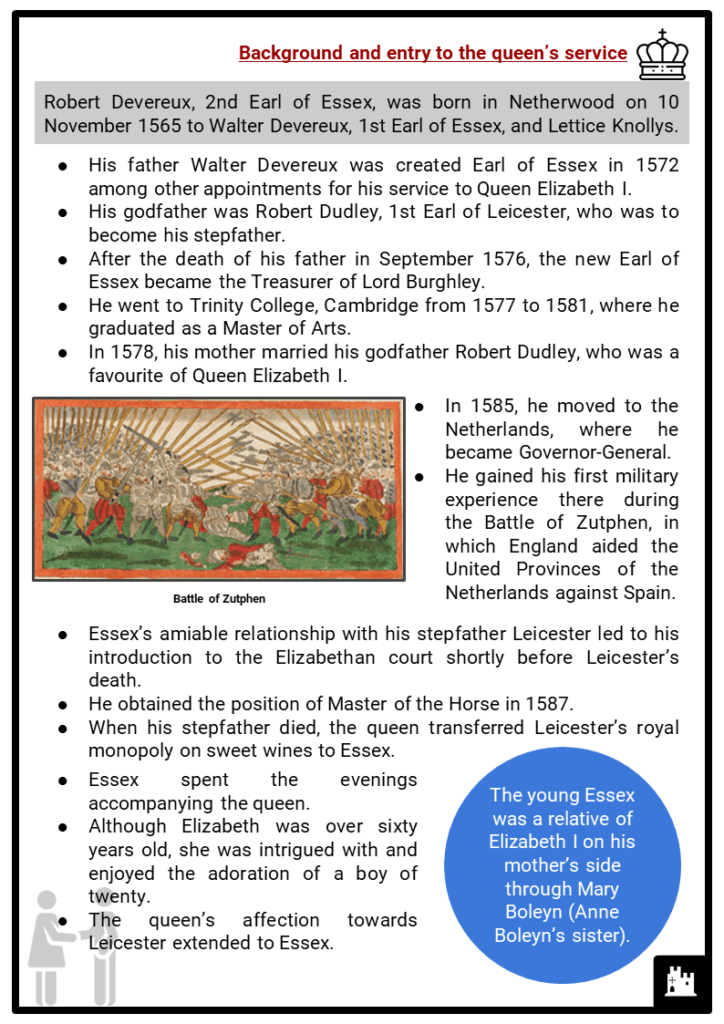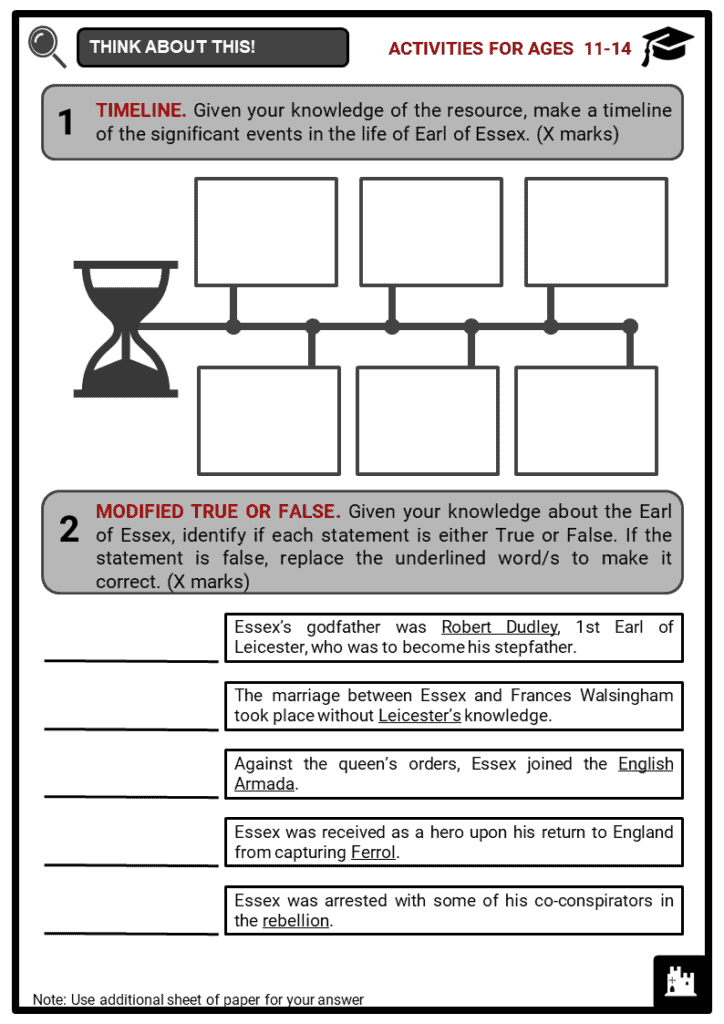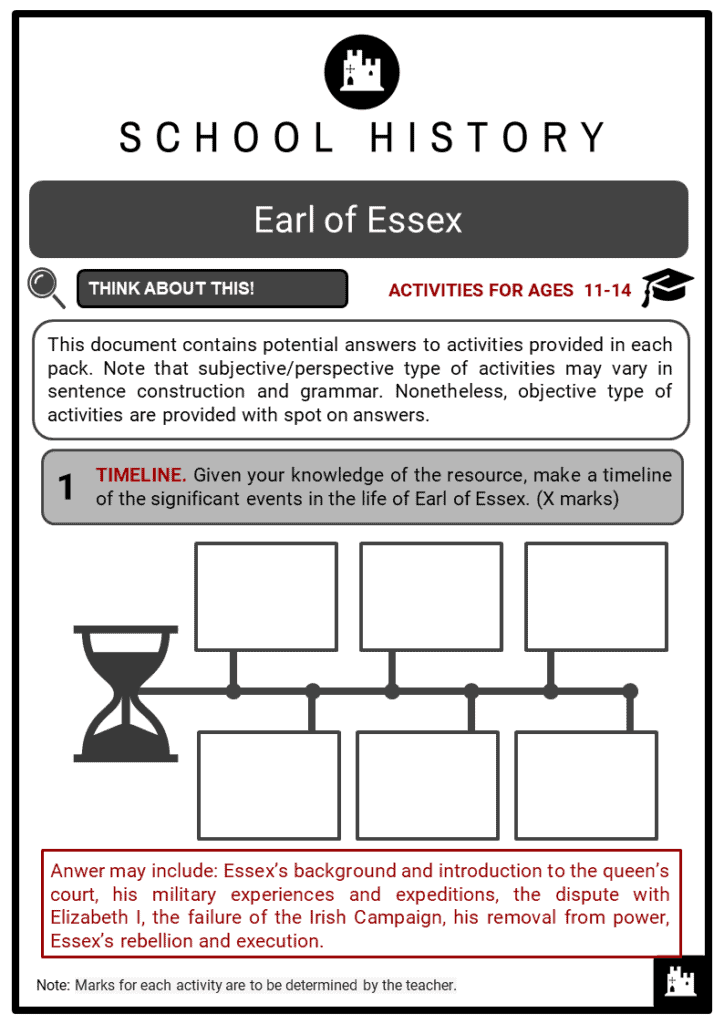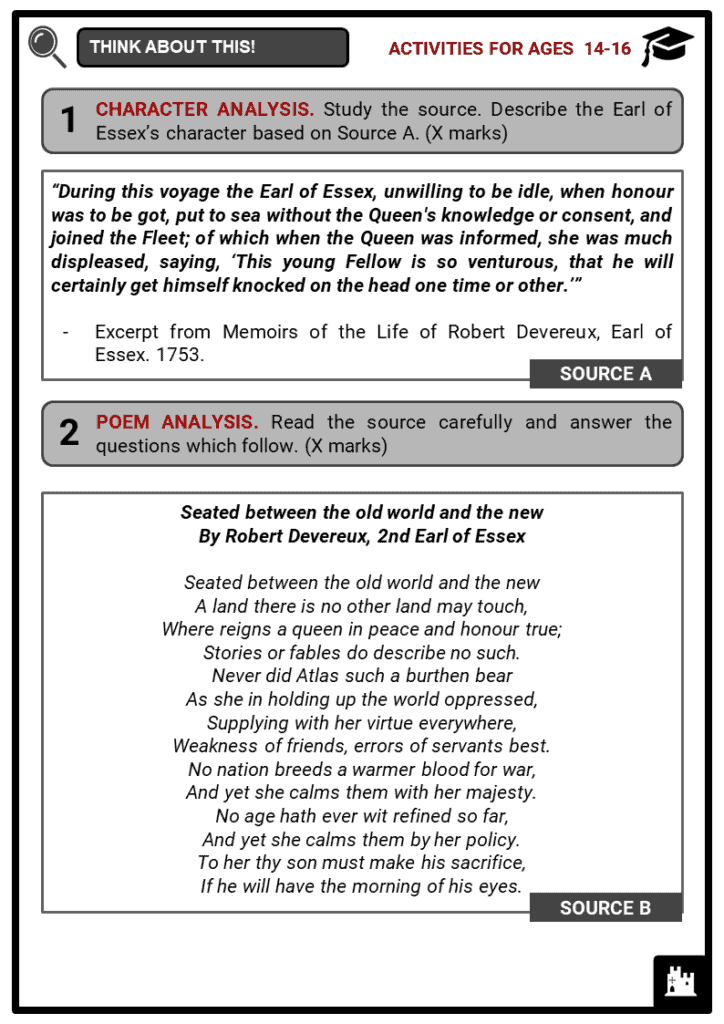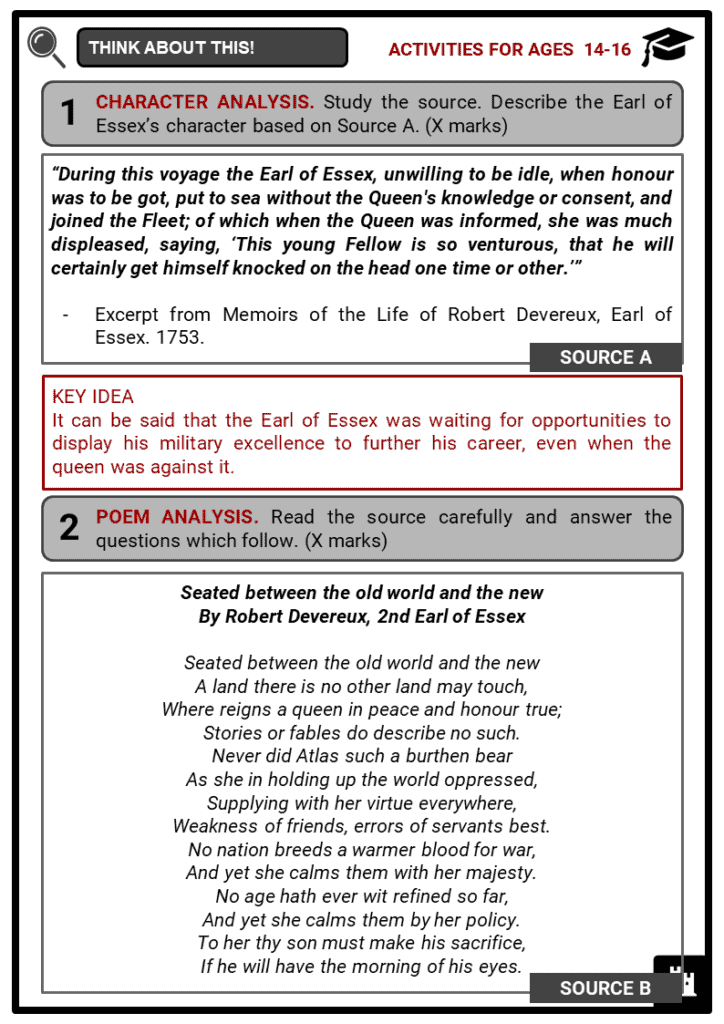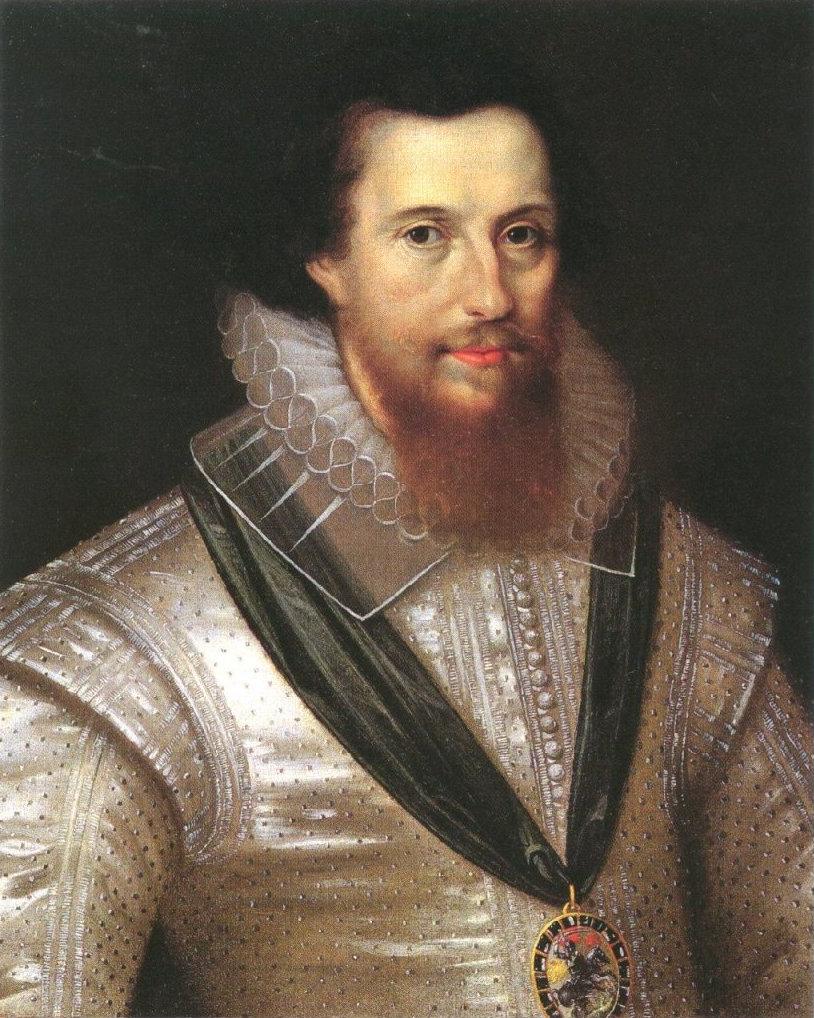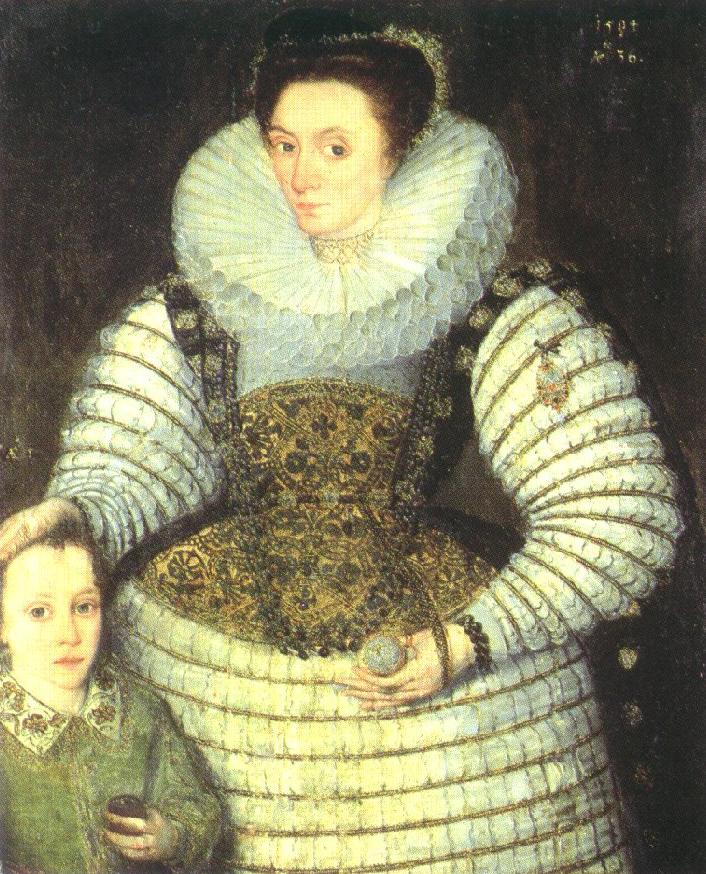Download Earl of Essex Worksheets
Do you want to save dozens of hours in time? Get your evenings and weekends back? Be able to teach Earl of Essex to your students?
Our worksheet bundle includes a fact file and printable worksheets and student activities. Perfect for both the classroom and homeschooling!
Table of Contents
Add a header to begin generating the table of contents
Summary
- Background and entry to the queen’s service
- Military expeditions and foreign affairs
- Dispute with Elizabeth I
- The failure of the Irish Campaign
- Essex’s rebellion and death
Key Facts And Information
Let’s know more about Earl of Essex!
- Robert Devereux was named the 2nd Earl of Essex after Walter Devereux’s death in 1576. He was introduced to the Elizabethan court by his stepfather Robert Dudley, 1st Earl of Leicester. He quickly became a favourite of Queen Elizabeth I because of his charm and eloquence. He led and was involved in various military expeditions, sometimes against the queen’s orders. After his failed military campaign against the Irish rebels in 1599, he was removed from power which eventually led to his conspiracy against the throne. He was tried and executed for treason on 25 February 1601.
Background and entry to the queen’s service
- Robert Devereux, 2nd Earl of Essex, was born in Netherwood on 10 November 1565 to Walter Devereux, 1st Earl of Essex, and Lettice Knollys.
- His father Walter Devereux was created Earl of Essex in 1572 among other appointments for his service to Queen Elizabeth I.
- His godfather was Robert Dudley, 1st Earl of Leicester, who was to become his stepfather.
- After the death of his father in September 1576, the new Earl of Essex became the Treasurer of Lord Burghley.
- He went to Trinity College, Cambridge from 1577 to 1581, where he graduated as a Master of Arts.
- In 1578, his mother married his godfather Robert Dudley, who was a favourite of Queen Elizabeth I.
- In 1585, he moved to the Netherlands, where he became Governor-General.
- He gained his first military experience there during the Battle of Zutphen, in which England aided the United Provinces of the Netherlands against Spain.
- Essex’s amiable relationship with his stepfather Leicester led to his introduction to the Elizabethan court shortly before Leicester’s death.
- He obtained the position of Master of the Horse in 1587.
- When his stepfather died, the queen transferred Leicester’s royal monopoly on sweet wines to Essex.
- Essex spent the evenings accompanying the queen.
- Although Elizabeth was over sixty years old, she was intrigued with and enjoyed the adoration of a boy of twenty.
- The queen’s affection towards Leicester extended to Essex.
- In 1590, Essex married Frances Walsingham, the daughter of an essential member of the queen’s council, Sir Francis Walsingham, and widow of Sir Philip Sidney, who was a war hero and the nephew of Leicester.
- Sir Philip Sidney died from an infection from a gun wound in the Battle of Zutphen.
- The marriage took place without Elizabeth’s knowledge: this upset the queen when she found out about the marriage.
- Robert Devereux and Frances Walsingham had several children including Robert, the future 3rd Earl of Essex.
Military expeditions and foreign affairs
- The circle of influential personalities that surrounded the queen began to diminish with the death of Sir Francis Walsingham, the most feared adversary of Spain and Catholicism in 1590, and of Christopher Hutton, another of Elizabeth’s courtiers in the following year.
- Meanwhile, Essex was pleased with the new opportunities that awaited him in life.
English Armada
- Against the queen’s orders, Essex joined the English Armada led by Sir Francis Drake and Sir John Norris.
- It was a failed attempt to attack Spain, after the defeat of the Spanish Armada the previous year.
- The English fleet lost many ships due to the defence of the Spanish naval forces and the stormy sea on their return.
Expedition to France
- Essex was fascinated by politics and by the tempting offers of the incoming King Henry IV of France.
- Henry IV asked Elizabeth to help him against the Catholic League and suggested that Essex was the ideal leader to command a reinforcement army.
- Elizabeth was persuaded and in 1591, she sent troops to France under Essex’s command.
- The queen’s young favourite quickly marched to the continent but his expedition was a significant failure.
- In fact, he was obliged to return to England much earlier than expected.
- Elizabeth was enraged for the second time that her favourite had acted against her requests, but his charm made way for their reconciliation.
Essex’s policy
- Essex soon became interested in a new ambition of crushing Spanish power and decided to follow in the footsteps of Leicester and Walsingham.
- Essex, therefore, became the leader of a group of young aristocrats and began to acquire increasing influence.
- In spite of this, there was also a group of people (including the statesman William Cecil and his son Robert Cecil), who believed he was dangerous.
- William and Robert Cecil believed that Essex should not be allowed to acquire too much power.
- They argued that he was incapable of providing the country with a good government.
- This caused them to clash with Elizabeth and rising politicians including the brothers Anthony and Francis Bacon.
- Anthony and Francis Bacon were William Cecil’s nephews, who allied themselves with Essex to take advantage of the influence and proximity he enjoyed with the queen.
- After his meeting with Anthony and Francis Bacon, Essex increased his political knowledge which led to his appointment to the queen’s Privy Council in 1593.
- This caused conflict to break out among Cecil, Essex, and the Bacon brothers.
- Having been appointed to perform high functions of government, Essex engaged in a series of intrigues and vehemently defended the interests of Anthony and Francis with ardour and obstinacy.
Capturing of Cádiz
- In 1596, Essex persuaded the queen to assign him to the command of a fleet, which was preparing to launch a new offensive against Spain.
- This time, the English ships managed to penetrate the port of Cádiz and were triumphant.
- Upon his return to England, Essex was received as a hero and even Cecil tried to become politically closer to him.
- However, Elizabeth was not entirely happy with the Earl’s triumph since the expedition had been very expensive and the revenues were scarce.
Essex-Raleigh Expedition
- In 1597, Essex led the campaign with Sir Thomas Howard and Sir Walter Raleigh to destroy the Spanish fleet at the port of Ferrol, occupy the Spanish possessions in the Azores Islands, and seize the Spanish treasure fleet as it passed through the Azores.
- The naval expedition was a failure and this contributed to the progressive loss of the queen’s favour towards Essex.
Dispute with Elizabeth I
- Despite Essex’s admiration for the queen and a triumph against Spain, Elizabeth was growing weary of him not following her orders.
- Whilst his eloquence and showman skills were admired by the queen, Essex’s ambition and rashness caused dispute in their relationship.
- Conflict between the two erupted in 1598 when the appointment of a new council member was discussed.
- Essex realised that the queen was not heeding his arguments and he, therefore, got up suddenly and turned his back on the queen with a contemptuous gesture.
- This insolence enraged Elizabeth who, in a fit of anger, lunged at him and twisted his ear violently.
- Essex retaliated by reaching for his sword but was quickly restrained by some assistants.
- He was removed by force and shouted that he would never come back to court.
The failure of the Irish Campaign
- The rebellion in Ireland that needed to be defeated provided an opportunity for Essex to reconcile with the queen through a successful conquest.
- In 1598, an Irish rebel, Hugh O’Neill, the Earl of Tyrone, won a resounding victory at the Battle of Yellow Ford against the English army in Ireland.
- This news reached the elderly Philip II, who promised support for the Irish rebellion.
- Tyrone had begun the rebellion in 1594 with the Battle of Clontibret, and the movement had spread throughout Ireland.
- In 1598, Elizabeth and her counsellors decided that it was time to act.
- This was an ideal occasion for Essex, who sought at all costs to reconcile with the queen after the embarrassing scene in the council, to put himself at the head of an army and leave for Ireland.
- The queen relented and appointed him Lord Lieutenant of Ireland, with orders to end the rebellion.
- The army set sail for Ireland in 1599: Essex had sworn to annihilate Tyrone.
- However, he realised upon his arrival that it was going to be more difficult than he anticipated and it would be hard to fulfil the queen’s orders.
- The expedition ended in a resounding failure for England.
- Realising his futile position, Essex made an even more serious mistake: without the queen’s permission, he initiated negotiations with Tyrone and proposed his safe return to England with part of his troops to depose the government but not dethrone Elizabeth.
- Tyrone accepted the proposal and the Essex returned to England. Fatigued and dirty, he went directly to Elizabeth and made his entrance into the royal chamber.
- Elizabeth had forbidden Essex’s return and was surprised to see him.
- The Privy Council declared Essex’s truce with Tyrone indefeasible and as a consequence, Essex was removed from public office and was taken to his house in London for confinement.
- He blamed this punishment on the influence of Raleigh and Cecil on the queen.
- Hugh O’Neill had been previously pardoned by Queen Elizabeth but went back to destroying English armies.
Essex’s rebellion and death
- Whilst his freedom was restored, Essex’s career was definitely over and the cancellation of the sweet wines monopoly made him desperate.
- He still made one last attempt to regain his former influence and gathered his numerous supporters to force an audience with Elizabeth.
- The goal was to coerce the queen to change the leaders in the government, particularly Robert Cecil, who had become more powerful after Essex’s removal.
- The rebellion was hastily planned and Essex’s followers disappeared after Cecil sent a warning that he was a traitor. Together with some of the co-conspirators, Essex was arrested.
- Essex was convicted of treason and was condemned to death by the queen. He was beheaded in the Tower of London on 25 February 1601. He was the last man executed inside the Tower.
Image sources:
[1.] https://upload.wikimedia.org/wikipedia/commons/5/58/Robert_Devereux%2C_2nd_Earl_of_Essex.jpg
[2.] https://upload.wikimedia.org/wikipedia/commons/0/03/Frances_Walsingham.jpg
[3.] https://upload.wikimedia.org/wikipedia/commons/7/7b/Elizabeth_I_%28Armada_Portrait%29.jpg


